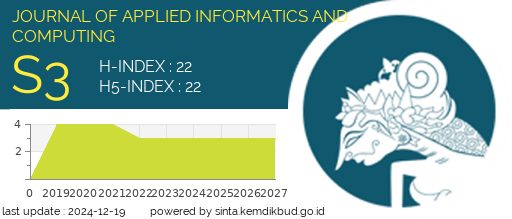Optimization of Random Forest Algorithm with Backward Elimination Method in Classification of Academic Stress Levels
DOI:
https://doi.org/10.30871/jaic.v9i3.9280Keywords:
Academic stress, Classification, Random Forest, Backward EliminationAbstract
Stress is a phenomenon experienced by all individuals as a natural response to pressure, which can impact mental and physical health. In an academic setting, the stress experienced by students is known as academic stress, which can affect their performance and mental well-being. Therefore, there is a need for effective prediction methods to aid in the management and prevention of academic stress. Therefore, there is a need to predict the level of academic stress to aid more effective management and prevention. This study uses a public dataset categorized based on the Student-life Stress Inventory (SSI), which includes psychological, physiological, social, environmental, and academic factors. Data mining is often used to detect diseases, one of which is the Random Forest algorithm. The Random Forest algorithm is applied as a classification technique for academic stress levels, with optimization using the Backward Elimination method for feature selection to improve model accuracy. The results showed that the accuracy of the Random Forest algorithm without feature selection obtained an accuracy of 86%, compared to the random forest algorithm with feature selection using the Backward Elimination method obtained a higher accuracy of 88%. This increase shows that the feature selection method can optimize model performance by selecting more relevant features. Thus, this research is expected to contribute to the management of student academic stress against the risk of academic stress.
Downloads
References
[1] S. Samarpita, R. Satpathy, P. K. Mishra, and A. N. Panda, “Mental Stress Classification from Brain Signals using MLP Classifier,” EAI Endorsed Trans. Pervasive Heal. Technol., vol. 9, no. 1, pp. 1–6, 2023, doi: 10.4108/eetpht.9.4341.
[2] K.Kesehatan, “Apa Itu Stres: Gejala, Penyebab, Pencegahan dan Pengobatan,” 2024. https://ayosehat.kemkes.go.id/apa-itu-stres
[3] P. D. Ambarwati, S. S. Pinilih, and R. T. Astuti, “Gambaran Tingkat Stres Mahasiswa,” J. Keperawatan Jiwa, vol. 5, no. 1, p. 40, 2019, doi: 10.26714/jkj.5.1.2017.40-47.
[4] D. D. W. Sari and W. Marsisno, “Klasifikasi Tingkat Stres Akademik dan Gambaran Mekanisme Koping Mahasiswa,” Semin. Nas. Off. Stat., vol. 2023, no. 1, pp. 203–212, 2023, doi: 10.34123/semnasoffstat.v2023i1.1691.
[5] H. B and R. Hamzah, “Faktor-Faktor Yang Berhubungan Dengan Tingkat Stres Akademik Pada Mahasiswa Stikes Graha Medika,” Indones. J. Heal. Sci., vol. 4, no. 2, p. 59, 2020, doi: 10.24269/ijhs.v4i2.2641.
[6] Afif Januar Ginata, Ratna Dewi Indi Astuti, and Julia Hartati, “Tingkat Stres Berdasarkan Jenis Stresor Pada Mahasiswa Tingkat Akhir Tahap Akademik Fakultas Kedokteran Unisba,” J. Ris. Kedokt., pp. 25–30, 2023, doi: 10.29313/jrk.vi.1915.
[7] P. H. Khrismadani, N. K. A. Sawitri, and P. O. Y. Nurhesti, “Gambaran Tingkat Stres Mahasiswa Keperawatan Universitas Udayana Dalam Proses Pembelajaran Selama Pandemi Covid-19,” Coping Community Publ. Nurs., vol. 10, no. 2, p. 166, 2022, doi: 10.24843/coping.2022.v10.i02.p07.
[8] W. Gamayanti, M. Mahardianisa, and I. Syafei, “Self Disclosure dan Tingkat Stres pada Mahasiswa yang sedang Mengerjakan Skripsi,” Psympathic J. Ilm. Psikol., vol. 5, no. 1, pp. 115–130, 2018, doi: 10.15575/psy.v5i1.2282.
[9] A. I. Noor Mahmudianti, Muhammad Riduansyah, “Journal of Health,” vol. 10, no. 1, pp. 47–54, 2024.
[10] M. A. Barata et al., “Perancangan Sistem Electronic Nose Berbasis,” pp. 117–126, 2016.
[11] E. R. B. Sebayang, Y. H. Chrisnanto, and Melina, “Klasifikasi Data Kesehatan Mental di Industri Teknologi Menggunakan Algoritma Random Forest,” IJESPG J., vol. 1, no. 3, pp. 237–253, 2023.
[12] E. S. Mohamed, T. A. Naqishbandi, S. A. C. Bukhari, I. Rauf, V. Sawrikar, and A. Hussain, “A hybrid mental health prediction model using Support Vector Machine, Multilayer Perceptron, and Random Forest algorithms,” Healthc. Anal., vol. 3, no. July 2022, p. 100185, 2023, doi: 10.1016/j.health.2023.100185.
[13] M. R. Fanani, “Algoritma Naïve Bayes Berbasis Forward Selection Untuk Prediksi Bimbingan Konseling Siswa,” J. DISPROTEK, vol. 11, no. 1, pp. 13–22, 2020, doi: 10.34001/jdpt.v11i1.952.
[14] C. Cahyaningtyas, D. Manongga, and I. Sembiring, “Algorithm Comparison and Feature Selection for Classification of Broiler Chicken Harvest,” J. Tek. Inform., vol. 3, no. 6, pp. 1717–1727, 2022, doi: 10.20884/1.jutif.2022.3.6.493.
[15] Chhabii, “Student Stress Factors: A Comprehensive Analysis,” kaggle.com, 2022. https://www.kaggle.com/datasets/rxnach/student-stress-factors-a-comprehensive-analysis/data
[16] N. N. Sholihah and A. Hermawan, “Implementation of Random Forest and Smote Methods for Economic Status Classification in Cirebon City,” J. Tek. Inform., vol. 4, no. 6, pp. 1387–1397, 2023, doi: 10.52436/1.jutif.2023.4.6.1135.
[17] D. Papakyriakou and I. S. Barbounakis, “Data Mining Methods: A Review,” Int. J. Comput. Appl., vol. 183, no. 48, pp. 5–19, 2022, doi: 10.5120/ijca2022921884.
[18] Y. APRILLIA, “Implementasi Algoritma Naive Bayes Dengan Feature Selection Backward Elimination Dalam Pengklasifikasian Status Penderita Stunting Pada Balita,” vol. 4, pp. 1–6, 2023.
[19] H. Nugroho, G. E. Yuliastuti, and A. Firman, “Klasifikasi Diagnosis Diabetes Melitus Menggunakan Metode Naïve Bayes Dengan Seleksi Fitur Backward Elimination,” J. Ilm. NERO, vol. 8, no. 2, p. 2023, 2023.
Downloads
Published
How to Cite
Issue
Section
License
Copyright (c) 2025 Salsabila Dani Amalia, Mula Agung Barata, Pelangi Eka Yuwita

This work is licensed under a Creative Commons Attribution-ShareAlike 4.0 International License.
Authors who publish with this journal agree to the following terms:
- Authors retain copyright and grant the journal right of first publication with the work simultaneously licensed under a Creative Commons Attribution License (Attribution-ShareAlike 4.0 International (CC BY-SA 4.0) ) that allows others to share the work with an acknowledgement of the work's authorship and initial publication in this journal.
- Authors are able to enter into separate, additional contractual arrangements for the non-exclusive distribution of the journal's published version of the work (e.g., post it to an institutional repository or publish it in a book), with an acknowledgement of its initial publication in this journal.
- Authors are permitted and encouraged to post their work online (e.g., in institutional repositories or on their website) prior to and during the submission process, as it can lead to productive exchanges, as well as earlier and greater citation of published work (See The Effect of Open Access).











